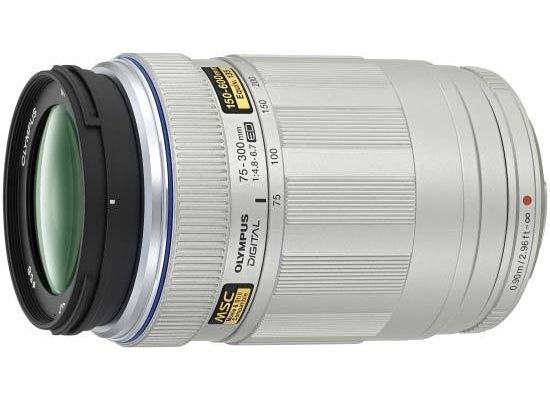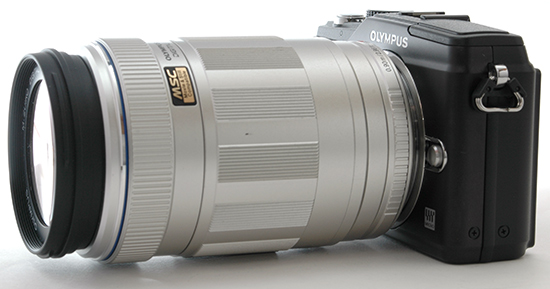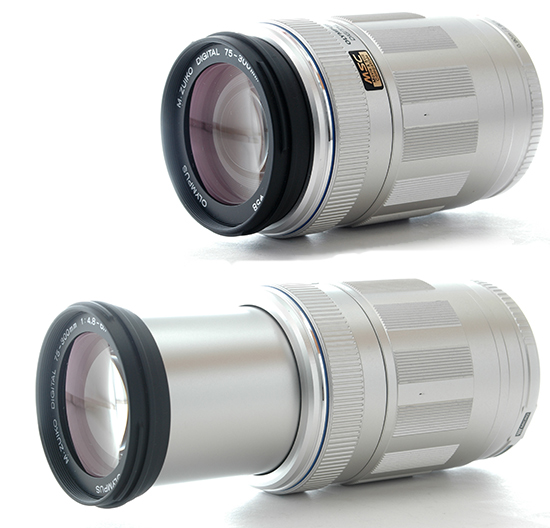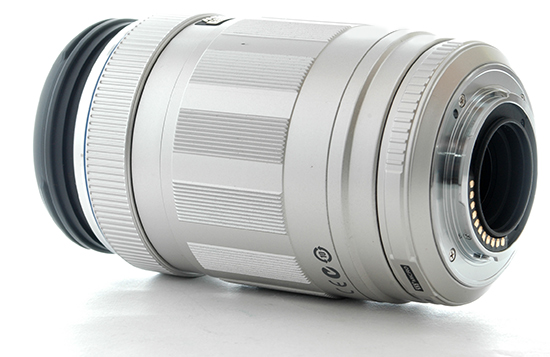Olympus Msc Ed M 75 to 300mm Review

Introduction
The Olympus M.ZUIKO Digital ED 75-300mm f/4.8-vi.7 is a new telephoto lens for the Micro Four Thirds system. Providing an effective focal range of 150-600mm in 35mm terms, the lens weighs only 430 grams, meaning information technology'southward currently the lightest 600mm equivalent interchangeable lens in the world. Constructed of 18 elements bundled in 13 groups, the lens boasts 2 ED elements and three highly refractive elements, and features a rear-focusing mechanism that's almost inaudible in use. The Olympus M.ZUIKO Digital ED 75-300mm f/4.8-6.7 lens is available for £799.99 / $899.95 in the United kingdom and the The states, respectively.
Ease of Use

Competing directly with the Panasonic Lumix Thousand Vario 100-300mm f/4.0-v.6 Mega O.I.Southward., the Grand.ZUIKO Digital 75-300mm f/iv.8-6.7 ED from Olympus offers telephoto enthusiasts using the Micro Four Thirds arrangement a marginally slower, but smaller and lighter alternative (albeit at a considerably higher price). As you can see from the photo above, it still dwarfs the Olympus Due east-PL2, making it look like the camera was attached to the lens rather than vice versa.
 Side of the lens
Side of the lens
The lens offers picayune in the way of features – there is no focus limiter, altitude scale or in-lens image stabilisation on offer. Given the slow maximum aperture at the long end, the lack of IS tin can be a problem, peculiarly if you wanted to utilise it for mitt-held photography on a non-stabilised torso.
 Zoomed in and zoomed out
Zoomed in and zoomed out
Zooming is not internal – as you can see, the front extends considerably upon zooming to 300mm. The zoom ring is sufficiently wide and neither too strong nor as well loose. Zoom creep is not an effect. The focus ring is narrow and ribbed, and is used to give impulses to the micromotor that moves the lens elements – in other words, information technology is not mechanically coupled. The lens accepts filters via a standard 58mm thread effectually the – non-rotating – front lens chemical element.
 Rear of lens, isometric view
Rear of lens, isometric view
The Olympus 75-300mm f/4.8-6.7 lens may accept a lot of plastic parts, simply the lens mountain is, thankfully, fabricated of metal. Olympus does not claim whatever sort of atmospheric condition resistance for this lens, and indeed you lot cannot run across a safe seal around the mount (note that no current Micro Iv Thirds camera is weather sealed anyhow).
Focal Range
At the 75mm end of the zoom range, the diagonal angle of view is sixteen degrees, equivalent to that of a 150mm lens in a 35mm organisation.
 Field of view at 75mm
Field of view at 75mm
At the 300mm end, the angle of view narrows to iv.1 degrees, which is the same as that of a 600mm lens on a 35mm full-frame camera.
 Field of view at 300mm
Field of view at 300mm
Focusing
With the lens attached to an Olympus E-PL2 camera trunk, focusing is fairly quick simply by no means instantaneous. As long as you are photographing still or slowly moving subjects, you will find the focusing speed entirely adequate. Switch your photographic camera's autofocus organisation to C-AF and endeavor to photograph something more than demanding – like birds in flying –, and you may find the AF speed lacking. Note: given that Micro Four Thirds cameras use contrast-detect autofocus, whose speed also depends on their sensors' read-out speed, the lens may perform better on a different or future MFT torso.
Transmission focusing is possible in a focus-by-wire mode. This should not put you off using it as it feels pretty natural in use, and actually enables the camera to display a magnified view of the subject automatically, i.due east. without your having to press a defended push button or enter the carte du jour. The focus ring is slim but adequate for the job.
Chromatic Aberrations
Chromatic aberrations, typically seen as purple or blue fringes along contrasty edges, are a non-issue with this lens. We were hard pressed to find any evidence of CA in the raw files.
Light Autumn-off
With the lens set to its maximum discontinuity, you can run across some low-cal fall-off in the corners, merely nothing excessive. You will likely only notice this when photographing a subject field with large homogeneous surfaces.
Macro
This is not a macro lens. Micro Four Thirds users who demand great close-up performance should check out the dedicated Leica DG Macro-Elmarit 45mm F2.8 ASPH. Mega O.I.Due south. or at to the lowest degree the Olympus Yard.ZUIKO Digital 14-150mm f/iv-5.6 ED superzoom, both of which accept been reviewed on this site.
 Close-up performance
Close-up performance
Bokeh Examples
Bokeh is a word used for the out-of-focus areas of a photograph, and is normally described in qualitative terms, such as smooth / creamy / harsh etc. In the M.ZUIKO Digital 75-300mm f/4.eight-six.vii ED, Olympus employed an iris diaphragm with seven rounded blades, which has resulted in a pretty overnice bokeh for a zoom lens, at to the lowest degree in our opinion. Nonetheless, recognising that bokeh evaluation is subjective, nosotros accept provided a few examples for your perusal.
Sharpness
In order to show you how precipitous this lens is, we are providing 100% crops on the post-obit folio.
- Ease
of Use - Sample
Images - Lens
Specs - Rating &
Conclusion
Source: https://www.photographyblog.com/reviews/olympus_m_zuiko_digital_ed_75_300mm_f_48_67_review
